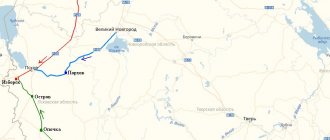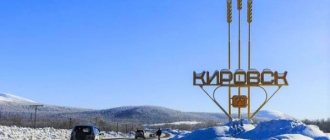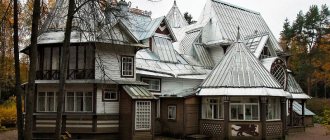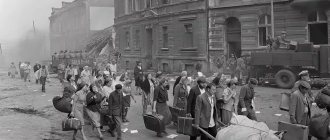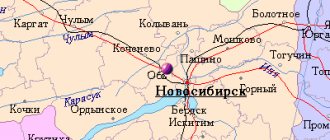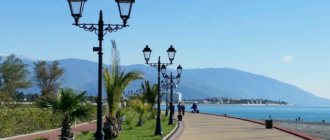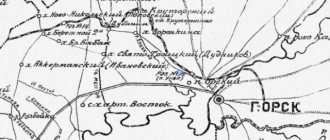The district includes a city and 17 village councils. The administrative center is the city of Pestovo , which is located at a distance of 314 km from the regional center (Veliky Novgorod).
Transport communication with the regional center is carried out in two ways:
- by railway Pestovo - Nebolochi - Okulovka - Veliky Novgorod;
- along the highway Pestovo - Borovichi - V. Novgorod.
In addition, the area is crossed by:
- railway, Moscow - St. Petersburg, 75 km long, in the Pestovsky district;
— the Valdai – Vologda highway, the section of which in the region is 70 km..
The length of asphalt roads is 251 km. The population of the district is 23,462 people, including 15,848 people in the city and 7,614 in the countryside.
History of the city of Pestovo.
Each city has its own unique appearance. The city of Pestovo is the embodiment of the beauty and spaciousness that is inherent in the Russian outback, it also clearly demonstrates the originality of the Russian character... This is all - the unique appearance of the Pestovo region, which at one time was often jokingly called the “bear corner”. But it is not so. Is it just that the name of the city of Pestovo, according to one version, comes from a peston bear that lived in these places more than half a century ago. Here is another assumption: the residents of the village of Russkoe Pestovo, at one time, were engaged in woodworking: they made pestles for mortars, which, in fact, became famous in the area. The name of the village allegedly comes from the word “pest”. The third version boils down to the fact that the first inhabitants of these places were the Pestov brothers.
Pestovo is one of the youngest cities in the Novgorod region , however, the history of the settlements that arose in these places has its roots in the distant past. There are at least 64 archaeological monuments (mounds, hills, zhalniki, settlements, settlements), which indicate
sustainable life more than a thousand years ago.
Unique ancient monuments in the vicinity of such villages as Klimovshchina, Ustye, Novinka are witnesses of the past centuries. The cluster of mounds near the village of Klimovshchina dates back to the 6th century. This category of monuments is one of the largest in the Novgorod region and indicates that the first peoples to settle the Pestov lands were Finno-Ugric tribes, whose main activities were hunting and fishing. Following them came the Krivichi, and a little later the Novgorod Slovenes, attracted by the rich pine forests.
Mention of the Mologa River, on the banks of which the first settlements arose, dates back to the 7th century, when the Grand Duke of Kiev Izyaslav Mstislavovich fought with Yuri Dolgoruky, Prince of Suzdal and Rostov.
The name of the settlement of Pestovo dates back to 1495 - a mention in the scribe book “Bezhetskaya Pyatina in the Bogoroditsky Pogost in Voldomitsky in Ormu to be proud.”
In 1912, by decree of the tsarist government, it was decided to build a railway connecting St. Petersburg and Moscow.
In 1919, the Pestovo ... In the same year, the first trains passed through the Volkhov-Rybinsk railway station.
In 1923, an agreement was concluded with German concessionaires on the construction of a plant at Pestovo station.
On December 6, 1924, the plant was launched. Its construction can be considered the beginning of the emergence of the village of Pestovo.
In 1927, a new administrative division took place in Russia, and the workers' village of Pestovo became the regional center of the Leningrad region.
In 1944, with the formation of the Novgorod region, the district transferred to this region.
On January 12, 1965, by Decree of the Presidium of the Supreme Soviet of the RSFSR, the village of Pestovo became a city of regional subordination.
In the Pestovsky district there are 54 monuments of urban planning and architecture, 9 historical monuments, 58 archaeological monuments.
— Church of the Holy Trinity (1814, Okhona village). Known as the earliest monument of stone architecture of the classicism period.
— Church of the Intercession of the Blessed Virgin Mary (mid-19th century, town of Pestovo).
— Church of the Presentation of the Blessed Virgin Mary into the Temple (19th century, Vyatka village).
— Church of the Nativity of the Virgin Mary (1856, Kirva village).
Historical monuments include one of the 4 lifetime busts of V.I. Lenin (1920), installed in the LK park.
Four holy springs are famous for their clean and healing water, although there are many more of them. One of them is near the village of Abrosovo, the other is between the villages of Uloma and Plavi. 1.5 km. From the village of Novoselki a third spring gushes out of the ground. The fourth - near the village. Ohona.
At all times, holy springs have been places of worship and Orthodox cult ceremonies.
The discreet, discreet beauty of these places is unique. It was here, in the Russian outback, that world-famous writers and artists drew inspiration.
On the outskirts of the village of Eremino, in a pine forest, on the high bank of the Meglinka River, there is a one-story building of the former zemstvo hospital. In the fall of 1893, the famous Russian writer G.I. visited here. Uspensky. In one of his stories, he describes the wonderful Ereminsky forest.
In the vicinity of the village of Laptevo from 1910 to 1914 M.M. lived and worked. Prishvin. A passionate hunter, lover and connoisseur of nature, he drew inspiration from these untouched places, finding new themes for his stories. He sang the beauty of the Pestovsky region in the book “In the Land of Unfrightened Birds.”
In 1933 - 1934, V.V. visited the Novgorod region for the first time. Bianchi. He came to Pestovskaya land three times and observed nature.
The Ustyuzhensky district and the Okhon hospital are mentioned in the essays of N.S. Leskov "Trifles of Bishop's Life".
Exquisite folklorist, ethnographer P.I. In 1860, Yakushkin traveled along the postal route, stopping in villages and hamlets, where he described the life and everyday life of the peasants of our region.
A.I. Kuprin hunted in these places more than once.
The famous Russian artist I. Shishkin noted in his travel diaries the virgin nature of the Pestovsky region, having visited our places.
Near the village Ohona, G. Ulanova’s parents rented a dacha, where the famous ballerina herself came twice.
Relief, geological structure and minerals.
The relief of the Pestovsky district has a gently undulating structure. The predominant heights are 100-200 meters above sea level. The last Valdai glaciation played the greatest role in the formation of the relief. No large mineral deposits have been discovered. There are deposits of peat, sand, and clay. There are about 40 peat deposits in the region with a total area of 8026 hectares.
Climate of the Pestovsky district.
Moderate continental, close to maritime. Winter is moderately cold, summer is moderately warm. The average temperature of the warmest month (July) is +16.8 C. The coldest month is January. Average temperature -10.3 C. Average annual precipitation 648 mm..
Vegetation and fauna.
The nature of the Pestovsky region is exceptional and diverse. For lovers of fishing and hunting, this is truly a fabulous land. The main wealth of the area is its forests. Spruce and pine predominate with an admixture of small-leaved species - aspen, birch, alder. The undergrowth contains rowan, willow, and juniper. The forests contain an abundance of cranberries, strawberries, lingonberries, blueberries, cloudberries, blueberries, and a lot of mushrooms. Brown bears, lynxes, wolves, hares, foxes, weasels, wild boars, and moose are found in the forests. Small rivers and quiet creeks are favored by beavers and muskrats. Among the birds, the most common are crossbill, wood grouse, great feathered woodpecker, nuthatch, tit, black grouse, partridge, ducks of various species, hazel grouse, woodcock, chaffinch, owl, eagle owl. Among the raptors there is the goshawk. In rivers and lakes there are: pike, bream, vendace, perch, roach, ruff, pike perch, carp. The smelt comes to spawn.
Land resources.
The land resources of the district are 211,000 hectares, of which farmland is 18%, forests are 71%.
The village of Pestovo during the war years
During the war, Pestovo and the surrounding areas were included in the front line. Streams of refugees from the western regions of the country are moving through the village. A small village on the banks of the Mologa sheltered 20 thousand children of hungry Leningrad. The evacuees were housed in schools and other educational institutions. Those able to work worked at the enterprises of the region. In the first days of hostilities, hundreds of Pestov residents went to the front. Young people of pre-conscription age and the elderly were also not left out. They organized battalions whose task was to fight saboteurs and sabotage groups. In 1941, several garment factories from Leningrad were moved to the territory of the village. Having settled in a new location, they produced products so necessary for the front.
Map
| Pestovo: maps |
Pestovo: photo from space (Google Maps) Pestovo: photo from space (Microsoft Virtual Earth)
| Pestovo. Nearest cities. Distances in km. on the map (in brackets along roads) + direction. Using the hyperlink in the distance , you can get the route (information courtesy of the AutoTransInfo website) | |||
| 1 | Sandovo (Tver region) | 37 (96) | SE |
| 2 | Lesnoye (Tver region) | 39 (52) | SW |
| 3 | Ustyuzhna | 44 (52) | NE |
| 4 | Chagoda (Vologda region) | 69 (173) | NW |
| 5 | Moshenskoye | 72 (96) | Z |
| 6 | Molokovo (Tver region) | 73 (139) | SE |
| 7 | Coniferous | 81 (101) | NW |
| 8 | Vesyegonsk | 84 (110) | IN |
| 9 | Babaevo | 87 (143) | WITH |
| 10 | Maksatikha (Tver region) | 89 (132) | YU |
| 11 | Udomlya | 92 (275) | SW |
| 12 | Red Hill | 96 (164) | SE |
| 13 | Kaduy (Vologda region) | 100 (190) | NE |
| 14 | Bezhetsk | 104 (184) | SE |
| 15 | Borovichi | 113 (129) | Z |
| 16 | Courts (Vologda region) | 117 (183) | NE |
| 17 | Sonkovo (Tver region) | 120 (217) | SE |
a brief description of
Located on the Mologo-Sheksninskaya lowland, on the river. Mologa (Volga basin), 314 km east of Veliky Novgorod.
Railway station.
Territory (sq. km): 15
Information about the city of Pestovo on the Russian Wikipedia site
Historical sketch
Founded in 1918 as a railway. Pestovo station during the construction of the Oktyabrskaya Railway; name after the village of Pestovo. Oikonym from the Russian nickname Pest, often found in Novgorod acts of the 15th-16th centuries.
The first train passed through Pestovo in 1919. In 1924, a sawmill opened in the village near the station.
Since September 19, 1927, the working village of Pestovo. Since 1965 the city of Pestovo.
Economy
JSC "Pestovsky Mechanical Plant".
In the Pestovsky district, grain crops, fiber flax, potatoes, and perennial grasses are grown. They raise cattle and pigs.
Main enterprises
BUILDING MATERIALS INDUSTRY
OJSC "Pestovsky Experimental Mechanical Plant"
174510, Novgorod region, Pestovsky district, Pestovo, Ustyuzhenskoye sh., 4
Offers:
Prefabricated buildings and structures, block containers
| Population by year (thousands of inhabitants) | |||||||
| 1931 | 3.1 | 1996 | 16.2 | 2008 | 15.8 | 2017 | 15.5 |
| 1939 | 7.9 | 1998 | 16.2 | 2010 | 15.7 | 2018 | 15.3 |
| 1959 | 14.2 | 2000 | 16.3 | 2011 | 15.9 | 2019 | 15.1 |
| 1967 | 16 | 2001 | 16.2 | 2012 | 15.9 | 2020 | 15.0 |
| 1970 | 15.8 | 2003 | 16.0 | 2013 | 15.8 | 2021 | 14.8 |
| 1979 | 15.5 | 2005 | 15.8 | 2014 | 15.8 | ||
| 1989 | 15.9 | 2006 | 15.8 | 2015 | 15.7 | ||
| 1992 | 16.1 | 2007 | 15.7 | 2016 | 15.6 | ||
How did Pestovo become the “Russian Klondike”?
Pestovo is a typical bear corner. A provincial settlement with a population of 16 thousand people, remote from both capitals. 450 km from Moscow, accessible only by crossroads. How did a real “Russian Klondike” appear here, where luck can smile on almost everyone?
Earning 80 thousand is not a problem
In the Pestovo district they have already been nicknamed the “capital of jeeps”. For a population of 16 thousand, 9 thousand cars are registered here. The town has restaurants, nightclubs, bowling alleys and sports bars. And there’s plenty to enjoy: the lowest salary here is 15 thousand rubles, which is given to beginners. Pros and workaholics earn significantly more.
“Earning from 80 to 100 thousand a month is not a problem,” local historian and journalist Alexey Vinogradov told Interlocutor. “Everyone can do this.” Who wants, of course.
How did it happen that, despite all the crises, bad government and difficult circumstances that we usually use to explain everything, a typical “American dream” was realized on the territory of an ordinary Russian provincial town?
Business on cabins
Many locals begin their story about the “golden era” of Pestovo with the figure of businessman Oleg Sterkhov. He is like a living legend here, which is also reinforced by his appearance - either an epic hero, or (there are such comparisons!) of the mythical Zeus. Broad shoulders, a lush beard, a calm look. Now Sterkhov is learning languages and reading a lot (in April he even participated in the show “Who Wants to Be a Millionaire?”), but before, according to the testimony of locals, anything could happen.
In the mid-1980s, Pestovo, like the whole of Russia, stood at a crossroads - to slide into the abyss or to be reborn. The planned economy collapsed, two large enterprises that ensured the well-being of Pestov residents began to wither away. A lawyer for one of the local factories, Oleg Sterkhov, quit his job at a state-owned enterprise and succumbed to the fashion for entrepreneurship. The stages were like everyone else’s: a video salon, where Pestov residents first saw erotic masterpieces like “Emmanuel,” a commercial tent with the then popular alcohol “Royal,” and, finally, a brokerage office.
“But, to be honest, trade has always somehow weighed on me,” Oleg Sterkhov admitted to Sobesednik.
Back in 1990, Sterkhov rented a workshop from a lumber mill “for testing.” They began to produce the simplest cabins. Sterkhov did not break the price, but maintained the quality, so his wooden “tents” began to be snapped up by both businessmen for workers and summer residents for their own plots. Thus, Sterkhov discovered the “law of cabins,” which became a formula for well-being for Pestovo:
– No matter how much you produce a good and inexpensive product, there will always be demand. Moreover, now the range has expanded - we also make houses from laminated veneer lumber, which are actively selling out throughout the country.
Over the course of 20 years, while cabins, block containers and wooden houses are being hammered into Pestovo, a local Forbes list has grown up here - 10-15 very rich people, each with their own fleet of 3-6 of the most expensive cars and the ability to drive around to the whole world. And Sterkhov is no longer in first place here, although many of Pestov’s “rich people” once worked for him.
For example, Oleg Kuzin, who started at the Sterkhov glass container collection point, and in his free time rode an old motorcycle to collect cranberries. A couple of berry harvests - and Kuzin was able to buy material for his first own change house. Now he is already a big businessman. But the difference between businessmen and workers is not always noticeable here. Pestov’s “rich people” do not live behind high fences, do not drive in armored cars and are not afraid of the common people.
– Sterkhov goes to the city bathhouse on weekends to steam, and last week he planted potatoes in his mother-in-law’s garden. In our city there is practically no class hatred, because our rich are the guys from the next street who received their capital not by inheritance or connections, but earned it literally in front of everyone. A cousin, for example, can still pick up a tool to personally correct or forge something. He rolls up his sleeves, and there the gold watch shines,” the locals laugh good-naturedly.
“It’s like this: a person will work for a season or two or three, and then he can open his own business if he has the strength and desire to work.” For us, this is a typical story of enrichment,” Alexey Vinogradov told Interlocutor.
Town life
Naturally, Pestovo is a real melting pot. Working people from many regions of the country and neighboring countries come here, where it is good and satisfying. But traditional Russian problems - unemployment, ethnic conflicts, drunkenness, neglected youth and rampant crime - all this is irrelevant here.
“Yes, when we are working,” the locals explain why they don’t sort things out with guest workers and don’t poke around in the entrances. Official unemployment in Pestovo is 0.5% - mostly women of pre-retirement age. Not a single unemployed man is registered in the city. Schoolchildren from the age of 15 are already asking to join the brigades - to knock down change houses and assemble houses and dachas from timber. At first, they are trusted only with work of the give-and-take type, and only after that they begin to teach skills that bring in very real money. A guy who picks up an ax or a plane can already be planning, for example, buying a car, starting a family and building his own house. Living examples are before your eyes.
“Although having a drink after a big payday is, of course, something we do according to Russian tradition,” the locals admit. - But not to the point of unconsciousness. It’s the same with us: he went on a drinking binge and lost his job. And if I lost my job, I lost everything.
The residents of Pestov call them “kurkuls”. They buy the best cars, build tall houses, and go abroad on vacation. True, the roads in Pestovo are terrible. Here you can immediately see how the state works, and how the Pestovites work. Therefore, people in the city are gossiping that Sterkhov has ambitions to go to power, because not all problems can be solved with money; levers of power are also needed.
“Nope,” Sterkhov himself laughs. – I once participated in elections, lost, and can’t stand it anymore. I jokingly tell my wife: maybe we can move to the Dominican Republic? But she, I, and everyone understand that I won’t go anywhere - there’s a lot of work. And every year more and more. Change houses and wooden houses in our undeveloped Russia will be the most popular goods for a long time... So there are a lot of tasks, you don’t have time to redo everything.
The local newspapers are always full of job advertisements. People are always needed for high-paying jobs. And there are never enough of them. Those who know how and want to work. And this is the formula for Pestov’s wealth. If only the whole of Russia could be nurtured like this!
Who else can live well in Rus'?
The city of Myshkin, Yaroslavl region. A mouse museum was opened here. The symbol of the city became the main souvenir and source of inspiration for Myshkin residents, and Myshkin itself became a center of tourism and the main source of income for both the treasury and ordinary residents.
Tsivilsk, Chuvashia. Residents of the city and eight adjacent villages are not fooling around, but wearing felt boots. In recent seasons, these shoes have become fashionable in the capitals, so that especially diligent Civilian felters earn up to 100 thousand a month.
Krasnoe-on-Volga, Kostroma region. This village is sometimes called the “golden Eldorado”. Most local residents are engaged in jewelry production. Almost 60% of Russian jewelry is made here, providing Russians with beautiful and inexpensive jewelry and tableware, and themselves with a stable and considerable income.
Photo by Alexey Vinogradov


